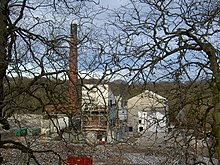Economy of Aberdeen
Traditional (pre 1970)

Most of the leading pre-1970s industries date from the 18th Century, amongst them woollens (1703), linen (1749), and cotton (1779). These gave employment to several thousands of operatives. The paper-making industry is one of the most famous and oldest in the city, paper having been first made in Aberdeen in 1694. The industry has however, collapsed. Culter Paper Mill closed in 1981, Donside Paper Mill closed in 2001 and the Davidson Mill (run by BPB Paperboard) in 2005. Flax-spinning and jute and combmaking factories also flourished, along with successful foundries and engineering works.
Granite
Very durable grey granite was
Fishing
Fishing, though once the predominant industry, was surpassed by the deep-sea fisheries, which derived a great impetus from improved technologies throughout the 20th Century. Lately, however, catches have fallen due to overfishing in previous years, and the use of the harbour by oil support vessels. Aberdeen remains an important fishing port, but the catch landed there is now eclipsed by the more northerly ports of Peterhead and Fraserburgh. The Fisheries Research Services is based in Aberdeen, including its headquarters and a marine research lab.
Agriculture research
Aberdeen is well regarded for the agricultural and soil research that takes place at
Footnotes
- ^ "History and Background". Rowett Research Institute. Archived from the original on 29 December 2006. Retrieved 1 February 2007.
- ^ "A Scientist's guide to Scotland". New Scientist. Archived from the original on 4 January 2007. Retrieved 8 February 2007.


